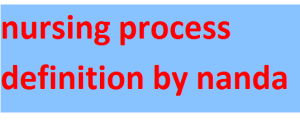nursing process definition by nanda 2024-2025
nursing process definition by nanda 2024-2025

At an international nursing conference held in Canada in 1982, the North American Nursing Diagnosis Association (NANDA) was established. The objective was to create a coordinated approach to nursing care in the United States and Canada. In 2002, NANDA included global input as it expanded internationally. The language and methods used to create a nursing diagnosis are standardized by NANDA.
The nursing process, as defined by NANDA (1990), is a five-step, systematic decision-making approach that focuses on identifying and treating individual or group responses to actual or potential changes in health. According to Nwonu (2002), the nursing process is a methodical, goal-oriented, dynamic set of activities used by the nurse to determine, plan, and carry out individualized nursing care with the goal of assisting the patient in achieving integration of his whole being or optimal wellness.
- . STEPS IN NURSING PROCESS Assessment Diagnoses Planning Implementation Rationale Evaluation. This six-step description of the nursing process, according to some theorists, is out of date and misrepresents nursing as linear and atomic (Kozier, Barbara, et al., 2004)
- STEPS IN NURSING PROCESS THE MODIFIED NURSING PROCESS: FROM HERDMAN T.H. 2013 Theory/ nursing science/ underlying nursing concepts Assessment/ patient history PLANNING Nursing diagnoses Nursing outcomes Nursing interventions. Implementation Continual re-evaluation
CHARACTERISTICS OF NURSING PROCESS
- The nursing process is cyclical and ongoing, and if the problem is solved, it can end at any stage. Every individual, family, and community has a problem that needs to be addressed through the nursing process. The process of nursing not only focuses on ways to meet a person’s physical needs but also their social and emotional needs. In order to inform each and every member of the healthcare team, the entire procedure is recorded or documented.
8. NANDA-International, formerly known as the North American Nursing Diagnosis Association, is the primary organization worldwide responsible for defining, disseminating, and integrating standardized nursing diagnoses. The new NANDA I edition, which was published between 2015 and 2017, has been thoroughly revised throughout. It contains 235 nursing diagnoses that are divided into 47 classes and 13 domains. Additionally, it contains 13 revised diagnoses and 25 new nursing diagnoses. To make things easier to understand, it uses standard diagnostic indicator terms like characteristics, related factors, and risk factors. A “sphere of knowledge” is referred to as a domain (Merriam-Webster, 2009). The following are examples of domains in the NANDA-I taxonomy: coping/stress tolerance, nutrition, elimination/exchange, activity/rest, or Classes are groups of attributes that are shared by all domains.
TYPES OF NURSING DIAGNOSES
- Actual / Problem focused diagnoses Risk diagnoses Wellness diagnoses Syndrome diagnosis
- 10. Components of nursing Diagnoses: PES or PE Actual Diagnoses: Problem statement/label/definition =P Etiology /related factors/causes=E Defining characteristics/ Signs &Symptoms =S Risk diagnoses: Problem statement/label/definition =P Etiology /related factors/causes=E Wellness diagnoses: Problem statement/label = P Syndrome diagnoses comprises of a cluster of problems. It is a statement. E.g. rape trauma syndrome. Qualifiers – are words added to the diagnostic label or problem statement to gain additional meaning. Examples are impaired, deficient, decreased, ineffective.
Click here for South African Nursing Colleges and Schools Application 2023-2024
RELATED LINKS
Nursing Online Application links